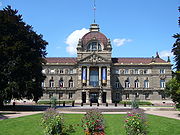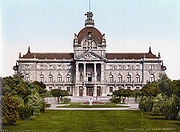
Palais du Rhin
Encyclopedia


Strasbourg
Strasbourg is the capital and principal city of the Alsace region in eastern France and is the official seat of the European Parliament. Located close to the border with Germany, it is the capital of the Bas-Rhin département. The city and the region of Alsace are historically German-speaking,...
, dominating the Place de la République (the former Kaiserplatz) with its massive dome
Dome
A dome is a structural element of architecture that resembles the hollow upper half of a sphere. Dome structures made of various materials have a long architectural lineage extending into prehistory....
. A huge building in itself, it constitutes, with the ample gardens that surround it as well as the stable
Stable
A stable is a building in which livestock, especially horses, are kept. It most commonly means a building that is divided into separate stalls for individual animals...
s next to it, one of the largest fully preserved landmarks of 19th century Prussia
Prussia
Prussia was a German kingdom and historic state originating out of the Duchy of Prussia and the Margraviate of Brandenburg. For centuries, the House of Hohenzollern ruled Prussia, successfully expanding its size by way of an unusually well-organized and effective army. Prussia shaped the history...
n architecture.
History
After the Franco-Prussian WarFranco-Prussian War
The Franco-Prussian War or Franco-German War, often referred to in France as the 1870 War was a conflict between the Second French Empire and the Kingdom of Prussia. Prussia was aided by the North German Confederation, of which it was a member, and the South German states of Baden, Württemberg and...
, Strasbourg, then German, was faced with the question of a reception for the emperor. To this end they wanted to create a symbol of imperial power. After much debate, the choice was made for a square Neo-Renaissance
Neo-Renaissance
Renaissance Revival is an all-encompassing designation that covers many 19th century architectural revival styles which were neither Grecian nor Gothic but which instead drew inspiration from a wide range of classicizing Italian modes...
styled building, remotely inspired by the Palazzo Pitti
Palazzo Pitti
The Palazzo Pitti , in English sometimes called the Pitti Palace, is a vast mainly Renaissance palace in Florence, Italy. It is situated on the south side of the River Arno, a short distance from the Ponte Vecchio...
in Florence
Florence
Florence is the capital city of the Italian region of Tuscany and of the province of Florence. It is the most populous city in Tuscany, with approximately 370,000 inhabitants, expanding to over 1.5 million in the metropolitan area....
.
Work began on March 22, 1884 to honour the 87th anniversary of William I
William I, German Emperor
William I, also known as Wilhelm I , of the House of Hohenzollern was the King of Prussia and the first German Emperor .Under the leadership of William and his Chancellor Otto von Bismarck, Prussia achieved the unification of Germany and the...
's birth nearly five years before it was finally completed. During construction many critiqued: the need and use of the building, its appearance, its price of three million marks
German mark
The Deutsche Mark |mark]], abbreviated "DM") was the official currency of West Germany and Germany until the adoption of the euro in 2002. It is commonly called the "Deutschmark" in English but not in German. Germans often say "Mark" or "D-Mark"...
.
Inaugurated by William II
William II, German Emperor
Wilhelm II was the last German Emperor and King of Prussia, ruling the German Empire and the Kingdom of Prussia from 15 June 1888 to 9 November 1918. He was a grandson of the British Queen Victoria and related to many monarchs and princes of Europe...
in August 1889, the palace would accommodate the emperor for twelve revivals until 1914.
During the First World War, the building was reconverted into a military hospital and in 1920 the building adopted its current name when the oldest of the European institutions, Central Commission for Navigation on the Rhine
Central Commission for Navigation on the Rhine
The Central Commission for Navigation on the Rhine is an international organization whose function is to encourage European prosperity by guaranteeing a high level of security for navigation of the Rhine and environs...
, moved in.
In 1923, the palace passed hands to the French state and accommodates the department of fine arts and the national furniture of Alsace-Lorraine
Alsace-Lorraine
The Imperial Territory of Alsace-Lorraine was a territory created by the German Empire in 1871 after it annexed most of Alsace and the Moselle region of Lorraine following its victory in the Franco-Prussian War. The Alsatian part lay in the Rhine Valley on the west bank of the Rhine River and east...
.
Transformed into Kommandantur by the Nazis from 1940 to 1945, the building is taken again by the troops of Leclerc
Philippe Leclerc de Hauteclocque
Philippe François Marie, comte de Hauteclocque, then Leclerc de Hauteclocque, by a 1945 decree that incorporated his French Resistance alias Jacques-Philippe Leclerc to his name, , was a French general during World War II...
who transform it into general quarters. It is there that he writes his proclamation announcing the realization of his oath at Kufra proclaiming that he would fight until flags flew over the cathedrals of Strasbourg
Strasbourg Cathedral
Strasbourg Cathedral or the Cathedral of Our Lady of Strasbourg is a Roman Catholic cathedral in Strasbourg, France. Although considerable parts of it are still in Romanesque architecture, it is widely consideredSusan Bernstein: , The Johns Hopkins University Press to be among the finest...
and Metz
Metz
Metz is a city in the northeast of France located at the confluence of the Moselle and the Seille rivers.Metz is the capital of the Lorraine region and prefecture of the Moselle department. Located near the tripoint along the junction of France, Germany, and Luxembourg, Metz forms a central place...
.
Threatened with destruction in the 1970s, the palace, classified as monument historique
Monument historique
A monument historique is a National Heritage Site of France. It also refers to a state procedure in France by which national heritage protection is extended to a building or a specific part of a building, a collection of buildings, or gardens, bridges, and other structures, because of their...
since 1993, accommodates now, in addition to the Central Commission for Navigation on the Rhine, the Direction régionale des Affaires culturelles (DRAC Alsace).
In 2008, the Palais was used as the setting of the Paris Gestapo
Gestapo
The Gestapo was the official secret police of Nazi Germany. Beginning on 20 April 1934, it was under the administration of the SS leader Heinrich Himmler in his position as Chief of German Police...
headquarters (historically situated in the Hôtel Lutetia
Hôtel Lutetia
The Hôtel Lutetia, located at 45 Boulevard Raspail, in the Saint-Germain-des-Prés area of the 6th Arrondissement of Paris, is one of the best-known hotels on the Left Bank...
) for the shooting of the French TV-miniseries "La Résistance".

